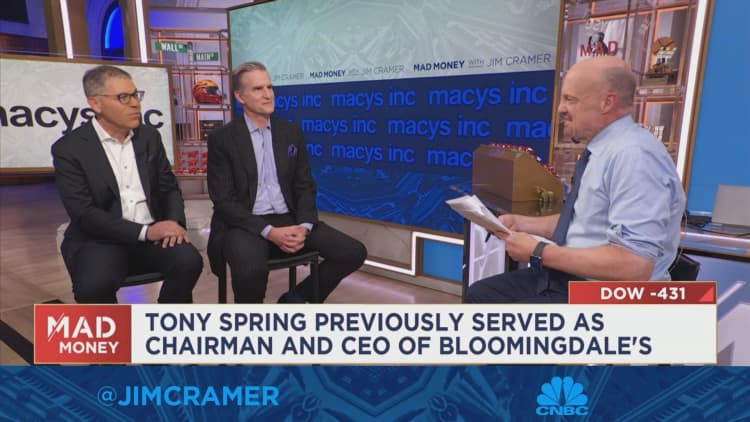Tony Spring speaks at an event unveiling the Macy's new women's apparel brand, On 34th, in July. Spring is former CEO of Bloomingdale's and begins as
Tony Spring speaks at an event unveiling the Macy’s new women’s apparel brand, On 34th, in July. Spring is former CEO of Bloomingdale’s and begins as Macy’s CEO in February 2024, succeeding longtime Macy’s CEO Jeff Gennette, right.
Melissa Repko | CNBC
Inside its headquarters in New York City’s Herald Square, Macy’s got ready to unveil its newest women’s clothing brand. Its incoming CEO Tony Spring prepared for his own reveal.
Spring took the stage in mid-July in front of fashion influencers, reporters and Macy’s employees, standing beside his soon-to-be predecessor, Jeff Gennette. He was at the pinnacle of his career, making his first public in-person appearance since being named CEO-elect of the 166-year-old department store operator.
Yet where many top executives would have lapped up the limelight, the 58-year-old retail veteran and leader of Macy’s higher-end department store chain Bloomingdale’s kept his remarks brief. He spoke for less than two minutes, then quickly stepped aside for On 34th, the company’s new brand of women’s clothing and accessories, to get the spotlight.
Spring will step onto a bigger stage and inherit the iconic department store’s issues when he takes over the role of Macy’s CEO on Sunday. His push to revive the retailer will depend in no small part on his ability to curate strong brands and store designs — and let the products win over shoppers.
Among the company’s challenges, Spring will contend with inflation-weary shoppers who continue to watch their discretionary spending, confront lower employee morale after more than 2,000 recent layoffs and stare down a contentious battle with activist investors. Macy’s has lost cachet with younger shoppers and brands who see its sprawling stores and endless aisles of merchandise as a relic of the past.
Investors have taken notice. Macy’s stock closed at $18.63 per share Friday, giving it a market cap of $5.11 billion. Shares have fallen about 24% in the last year.
Spring will face existential questions about how Macy’s can stay relevant and grow rather than shrink, as competitors such as Amazon, T.J. Maxx and even Target and Walmart steal away sales. He will also lead Macy’s promising efforts to chase suburban shoppers with smaller stores in strip malls, expand its offerings of trendier exclusive brands and luxury names, and build on the strong performance of newer businesses such as its beauty chain, Bluemercury, and its off-price business, Backstage.
In CNBC interviews, current and former Macy’s employees, industry leaders and investors said Spring will bring a deep retail background, a merchant’s sharp eye and credibility with coveted national and global brands from his decades at Bloomingdale’s.
Yet they acknowledged the new CEO will have his hands full. Some expressed concern that as a longtime executive at the company, Spring won’t bring the same scrutiny an outsider would.
“When you have an internal appointment, you don’t tend to see that much shake-up in the wider team, and sometimes that’s needed,” said Neil Saunders, managing director of research firm GlobalData. “The biggest risk is just really that. Someone new comes in the post, but we just see a continuation of the same old strategies without much new thinking.”
Macy’s declined interview requests for this story, but Gennette praised Spring as the right person for the job when the company announced his retirement and his successor’s appointment in March. Gennette pointed to Bloomingdale’s strong results — the higher-end department store has outperformed the namesake Macy’s brand in recent years — and described Spring as “an ally and trusted partner in advancing Macy’s, Inc.’s strategies.”
“Tony consistently innovates for the customer, is an exceptional brand builder and an excellent talent developer who has strengthened our culture through his leadership,” he said in the news release.

‘A merchant at heart’
Spring’s ascension to the top role at Macy’s is the culmination of nearly four decades with the retailer. Fresh from graduation from Cornell University, he was hired by Bloomingdale’s in 1987 as an executive trainee in the White Plains, New York, store.
He moved up the ranks, ultimately becoming CEO of the higher-end department store in 2014.
Even as he rose, Spring described himself as committed to one of retail’s key building blocks: making sure stores draw customers in, invite them to linger and surprise them with beautiful displays and items they didn’t know they needed. It’s a touch shoppers and Wall Street believe Macy’s could use as it fights for relevance.
“I’m a former merchant,” he told the audience at the launch event for Macy’s “On 34th” brand in July. “I still consider myself a merchant at heart.”
Bloomingdale’s is known for having a knack for understanding customers and which brands to carry. The chain, which has 55 locations across the country, has been a crown jewel of its parent company despite its smaller size. It carries pricey and prominent luxury brands, including Theory, Sandro and Alice + Olivia, but also has popular and more affordable in-house brands, such as Aqua.
It has also drawn shoppers with limited-edition pop-ups and collections of merchandise that tap into the cultural zeitgeist or cater to the Instagram and TikTok generations, such as an exclusive Barbie-themed clothing line.
Macy’s namesake brand accounts for most of its stores and revenue, yet Bloomingdale’s and Bluemercury have seen better sales trends.
On CNBC’s “Mad Money” in October, Spring said his time at Bloomingdale’s reinforced “it’s all about curation of product and the delivery of a better experience for the customer.”
“Retail is theater,” he said in the interview.
He described Bloomingdale’s as “a growth vehicle” but said the company’s namesake brand can be one, too.
“We’re talking to different customers and we can obviously learn from one another without becoming one another,” he said.
GlobalData’s Saunders has criticized Macy’s for sloppy displays, bland merchandise and poor customer service at its namesake stores. He said after leading “the better-run part of the business” in Bloomingdale’s, Spring needs to bring those “softer skills” to Macy’s.
“Get some pride back into the business,” he said. “That might mean making some investments. It might mean putting back in visual merchandising teams. It might mean investing more in staff and labor hours, but I think it’s a decision worth taking. And it’s a relatively easy win.”
Spring will have tougher tasks, though, Saunders said. In a competitive industry, Macy’s needs a sharper identity to compete with specialty retailers, big-box stores and off-price players that often beat the department store on convenience, value and fashion, he said.
And, he added, Spring must take a hard look at the company’s real estate footprint to decide where it should shut stores, shrink locations or expand outside the mall.
Wooing investors and brands
In his new role, Spring will have to charm investors, shoppers and hot brands. It’s a delicate balance, as its efforts to boost sales, make the store experience more appealing to customers and win over investors hungry for profits could at times clash.
As its stock value has eroded, Macy’s has gotten smaller by most other key metrics, too. Over the past decade, the company has closed about a third of its namesake stores. Its annual net sales have fallen during that same period, from about $28 billion in 2013 to $24.4 billion in the last full fiscal year it has reported, which ended in late January 2023.
Its employee count has fallen by about 45% from 2013 to 94,600 people as of the end of that fiscal year.
Macy’s announced Jan. 18 that it will shrink its head count and store footprint even more. It laid off more than 2,300 employees and announced it will shutter five more of its namesake stores.
Macy’s struggles have turned the retailer into a target for the activist investors Spring will face down as he becomes CEO. Its board last month rejected a $5.8 billion proposal by Arkhouse Management and partner Brigade Capital Management to acquire the shares of the retailer that they don’t already own and take the department store operator private.
In an interview on CNBC after that rejection, Arkhouse managing partner Gavriel Kahane signaled that he hasn’t given up yet. He called on Macy’s to open up its books to the investors, or the firm will take the matter to shareholders, he said.

Investors will get their best glimpse into the health of the company Spring is inheriting in late February, when Macy’s is expected to report its holiday-quarter results and its outlook for the year ahead. In the previous quarter, the retailer said it expected same-store sales to decline by up to 7% in the fiscal year that ended in late January.
Though the company’s sales are sagging, Spring will take over promising pockets of the business, as well. Its smaller stores, which Macy’s is opening in a growing number of strip malls, have outperformed sales at its traditional, mall-based locations. After launching the women’s clothing brand On 34th, Macy’s plans to debut and refresh other lines that shoppers can find only at its stores and on its website. That private brand strategy has succeeded for other retailers, such as Target.
Spring’s career as an insider has raised concerns among some industry analysts. A Macy’s spokesperson said that while Spring came up through Macy’s, he has pushed for adding fresh perspectives to the retailer’s leadership team. Many of the company’s recent top hires have come from the outside.
Those include his successor at Bloomingdale’s, Olivier Bron, who was most recently CEO of department stores in Thailand; and Sharon Otterman, Macy’s new chief marketing officer, who came from Caesars Entertainment.
Having the right national brands will also shape Macy’s future success. It’s another area where Spring’s experience as a merchant could benefit the company.
Compared with rival Nordstrom, Macy’s has been slow to add younger and newer brands that can draw fashion-forward customers.
As Macy’s expands its third-party marketplace, some new brands have joined its website. One of those is Untuckit, a men’s apparel brand typically sold directly through its own stores and website.
Just ahead of the holiday season, the company’s clothing debuted on Macy’s website. It was Untuckit’s first meaningful push into wholesale, said the brand’s CEO and co-founder Aaron Sanandres.
Sanandres said he saw Macy’s as a way to reach shoppers who haven’t yet discovered Untuckit. Now, he said, it’s considering its next moves in wholesale — including the possibility of selling apparel at Macy’s stores.
Yet he said he has grappled with the same questions that other popular brands may have. Will merchandise get confined to a corner of Macy’s huge stores? Will its reputation take a hit from being carried by a retailer associated with old-school malls or 40%-off signs? Can it keep tight control over its own brand’s level of promotions?
“There are a lot of conversations around that, and it’s partly why we’re baby-stepping into the relationship to make sure we don’t see any negative pushback from our customer,” he said.
One of the most crucial parts of Spring’s job will be attracting millennial and Gen Z shoppers who don’t share the same loyalty as their parents and grandparents to Macy’s namesake stores and website, said Oliver Chen, an equity research analyst for TD Cowen.
Winning those shoppers over will come down to having better merchandise and a sense of style, he said.
“You need to be inspired by Macy’s,” he said. “The customer doesn’t necessarily want the cheapest thing from Macy’s. They want a nice, fashion-forward thing.”
Some of those shoppers are like Annie Rush. On a recent weekday, she zipped in and out of Paramus Park mall in New Jersey to make a purchase for one of her teenage sons.
Rush said she prefers to shop online, where she can search for what she wants with the help of filters. At a Macy’s store, the sea of options can be overwhelming, she said.
“Sometimes they offer too many things,” Rush said. “It’s like decision paralysis. You can’t find what you want or have to dig.”
With an Old Navy bag in hand, she cut through Macy’s only to get to the mall’s parking lot.
— CNBC’s Gabriel Cortes contributed to this report.
www.cnbc.com

COMMENTS